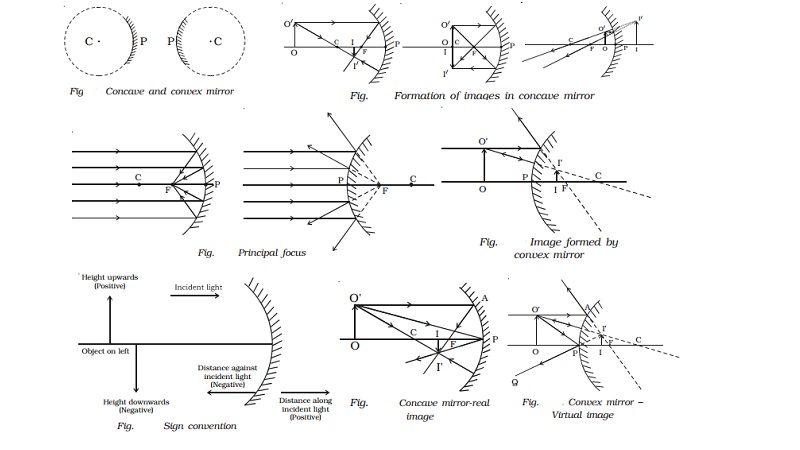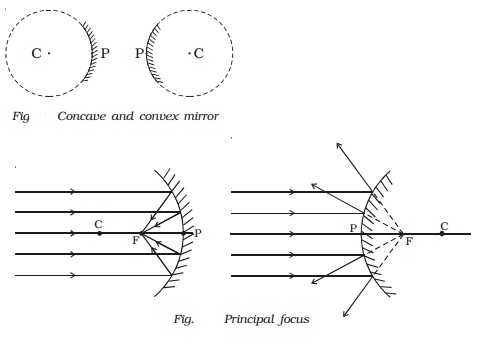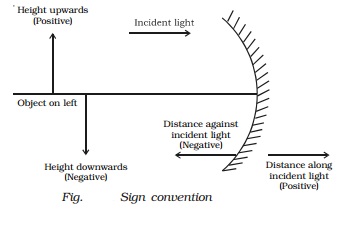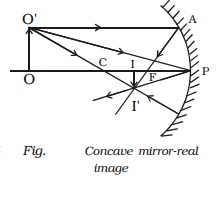Chapter: 11th 12th std standard Class Physics sciense Higher secondary school College Notes
Reflection at curved surfaces

Reflection at curved surfaces
In
optics we are mainly concerned with curved mirrors which are the part of a
hollow sphere (Fig. ). One surface of the mirror is silvered. Reflection takes
place at the other surface. If the reflection takes place at the concave
surface, (which is towards the centre of the sphere) it is called concave
mirror. If the reflection takes place at the convex surface, (which is away
from the centre of the sphere) it is called convex mirror. The laws of
reflection at a plane mirror are equally true for spherical mirrors also.

The centre of the
sphere, of which the mirror is a part is called
the centre of curvature (C).
The geometrical centre
of the mirror is called its pole (P).
The line joining the
pole of the mirror and its centre of curvature
is called the principal axis.
The
distance between the pole and the centre of curvature of the spherical mirror
is called the radius of curvature of
the mirror and is also equal to the radius of the sphere of which the mirror
forms a part.
When a parallel beam
of light is incident on a spherical mirror, the point where the reflected rays
converge (concave mirror) or appear to diverge from the point (convex mirror)
on the principal axis is called the principal
focus (F) of the mirror. The distance between the pole and the principal focus is called the focal length (f) of the mirror (Fig. ).
1.Images formed by a
spherical mirror
The images produced by
spherical mirrors may be either real or virtual and may be either larger or
smaller than the object. The image can be located by graphical construction as
shown in Fig. by adopting any two of the
following rules.

(i) A ray parallel to the
principal axis after reflection by a concave mirror passes through the
principal focus of the concave mirror and appear to come from the principal
focus in a convex mirror.
(ii)
A ray passing through the centre of curvature retraces its path
after reflection.
(iii)A ray passing through the principal focus,
after reflection is rendered parallel to the principal axis.
(iv)A ray striking the pole at an angle of
incidence i is reflected at the same angle i to the axis.
2 Image formed by a convex mirror
In a convex mirror
irrespective of the position of the object, the image formed is always virtual,
erect but diminished in size. The image
lies between the pole
and the focus (Fig. ).

In
general, real images are located in front of a mirror while virtual images
behind the mirror.
3 Cartesian sign
convention
The following sign
conventions are used.

(1)All distances are measured from the pole of
the mirror (in the case of lens from the optic centre).
(2)The distances measured in the same direction
as the incident light, are taken as positive.
(3)
The distances measured in the direction opposite to the
direction of incident light are taken as negative.
(4) Heights measured
perpendicular to the principal axis, in the upward direction are taken as
positive.
(5) Heights measured
perpendicular to the principal axis, in the downward direction are taken as
negative.
(6) The size of the object
is always taken as positive, but image size is positive for erect image and
negative for an inverted image.
(7)The magnification is positive for erect (and
virtual) image, and negative for an inverted (and real) image.
4.Relation between u, v and f for spherical mirrors
A mathematical
relation between object distance u,
the image distance v and the focal
length f of a spherical mirror is
known as mirror formula.
(i) Concave mirror - real image
Let us consider an
object OO′ on the principal axis of a concave mirror beyond C. The incident and
the reflected rays are shown in the Fig . A ray O′A parallel to principal axis
is incident on the concave mirror at A, close to P. After reflections the ray passes through the
focus F. Another ray O′C passing through centre of curvature C, falls normally
on the mirror and reflected back along the same path. A third third ray 0?P
incident at the pole P is reflected along PI′. The three reflected rays intersect at the point I′. Draw perpendicular I′I to the principal axis. II′ is the real, inverted image of the object
OO?.

Right angled
triangles, II?P and OO?P are similar.
II? / OO? = PI/PO
????..(1)
Right angled triangles
II′F and APF are also similar (A is close to P ; hence AP is a vertical line)
II?/Ap = IF/PF ???(2)
Comparing the
equations (1) and (2)
PI/PO = IF/PF ????(3)
But, IF = PI ? PF
Therefore equation (3)
becomes
PI/PO = ( PI-PF ) /
PF ???..(4)
Using sign
conventions, we have PO = ?u,
PI = -v and PF = -f
Substituting the
values in the above equation, we get
[( -v/-u )] - [(-v-(-f))(-f)]
Or
v/u = (v-f)/f=(v/f) ?
1
Dividing by v and
rearranging, 1/u + 1/v = 1/f
This is called mirror
equation. The same equation can be obtained for virtual image also.
(ii) Convex mirror - virtual image
Let us consider an
object OO′ anywhere on the principal axis of a convex mirror. The incident and
the reflected rays are shown in the
Fig.. A ray O′A
parallel to the principal axis incident on the convex mirror at A close to P.
After reflection the ray appears to diverge from the focus F. Another ray O′C
passing through centre of curvature C, falls normally on the mirror and is
reflected back along the same path. A third ray O ′P incident at the pole P is
reflected along PQ. The three reflected rays when produced appear to meet at
the point I′. Draw perpendicular II′ to the principal axis. II′ is the virtual
image of the object OO′.

Right angled
triangles, II ′P and OO ′P are similar.
II?/OO? = PI/PO ??(1)
Right angled triangles
II ′F and APF are also similar (A is close to P; hence AP is a vertical line)
II? / AP = IF/PF
AP = OO ′. Therefore
the above equation becomes,
II?/OO? = IF/PF ??.(2)
Comparing the
equations (1) and (2)
PI/PO = IF/PF ????(3)
But, IF = PF ? PI.
Therefore equation (3) becomes,
PI/PO = (PF-PI) / PF
Using sign
conventions, we have PO = -u, PI = +v and PF = +f. Substituting the values in
the above equation, we get
+v/-u = +f-(+v) / +f
-v/u = (f-v) / f = 1 ? (v/f)
This is called mirror
equation for convex mirror producing virtual image.
5.Magnification
The linear or
transverse magnification is defined as the ratio of the size of the image to
that of the object.
∴Magnification = size of
the image / size of the object = h2/h1
where h1
and h2 represent the size of the object and image respectively.
From Fig. it is known that II?/
OO? = PI/
PO
Applying the sign conventions,
II′ = ?h2 (height of
the image measured downwards)
OO ′ = +h1 (height of
the object measured upwards)
PI = ?v (image
distance against the incident light)
PO = ?u (object
distance against the incident light)
Substituting the
values in the above equation, we get
magnification m =( -h2)/(+h1)
= -v/-u
For an erect image m
is positive and for an inverted image m is negative. This can be checked by
substituting values for convex mirror
also.
Using mirror formula,
the equation for magnification can also be obtained as
m = h2/h1
= -v/u = (f-v)/f = f /(f-u)
This equation is valid
for both convex and concave mirrors.
Related Topics